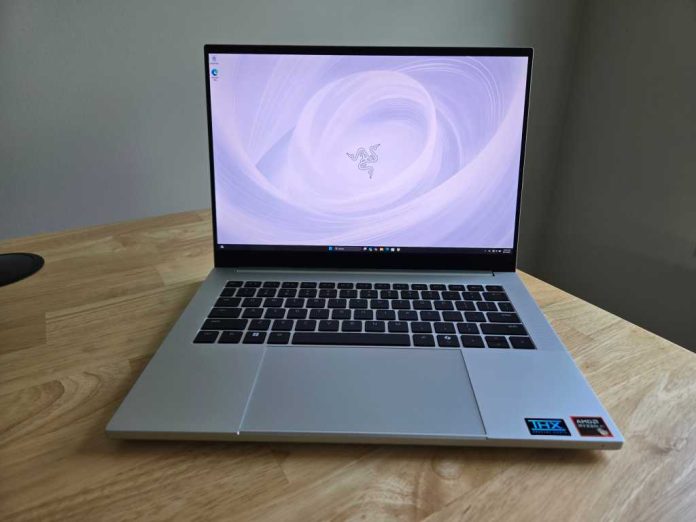
Image: IDG / Chris Hoffman
 At a glance
At a glance
Expert’s Rating
Pros
- Thin, light, and compact
- Solid gaming performance
- Beautiful OLED display
- Premium quality all around
Cons
- Expensive
- Bulkier gaming laptops will perform better
Our Verdict
The Razer Blade 14 delivers high gaming performance in cool, quiet, compact package with premium build quality. Its OLED display is beautiful, too. But it’s expensive.
Price When Reviewed
This value will show the geolocated pricing text for product undefined
Best Pricing Today
Best Prices Today: Razer Blade 14 (2025)

The Razer Blade 14 is a 14-inch gaming laptop that’s not much larger, thicker, or heavier than the average laptop. From the snappy keyboard to the quiet fans to the beautiful display, everything works as well as I hoped it would. This machine delivers exactly what it promises. Best of all, you don’t have to choose between power and portability.
Razer Blade 14: Specs
The Razer Blade 14 is a premium 14-inch gaming laptop that comes with an AMD Ryzen AI HX 365 CPU, based on AMD’s Zen 5 architecture. Our review unit was a $2,699 model that comes with Nvidia GeForce RTX 5070 graphics, 32GB of LPDDR5X RAM, and a 1TB SSD. (It also has AMD Radeon 880M graphics, to save power when the beefy Nvidia GPU isn’t needed.)
Razer also offers a lower-end $2,299 model that comes with RTX 5060 graphics and 16 GB of RAM along with a $2,999 model that includes 64 GB of RAM and a 2 TB SSD.
AMD’s Ryzen AI hardware comes with an NPU, so you get access to Copilot+ PC AI features on this laptop.
- Model number: Razer Blade 14 (2025)
- CPU: AMD Ryzen AI 9 365
- Memory: 32GB LPDDR5X RAM
- Graphics/GPU: Nvidia GeForce RTX 5070 and AMD Radeon 880M
- NPU: AMD NPU (up to 50 TOPS)
- Display: 2880×1800 OLED display with 120Hz refresh rate
- Storage: 1TB PCIe Gen4 SSD
- Webcam: 1080p webcam
- Connectivity: 2x USB Type-C (USB4), 2x USB Type-A (USB 3.2 Gen 2), 1x combo audio jack, 1x HDMI 2.1, 1x microSD slot, 1x power port, 1x Kensington lock slot
- Networking: Wi-Fi 7, Bluetooth 5.4
- Biometrics: IR camera for Windows Hello
- Battery capacity: 72 Watt-hours
- Dimensions: 12.23 x 8.83 x 0.62 inches
- Weight: 3.59 pounds
- MSRP: $2,699 as tested
The Razer Blade 14 is an excellent gaming laptop in a small package. If you want premium build quality, great gaming performance, and a beautiful display in a compact 14-inch laptop package, it’s a great option.
Razer Blade 14: Design and build quality
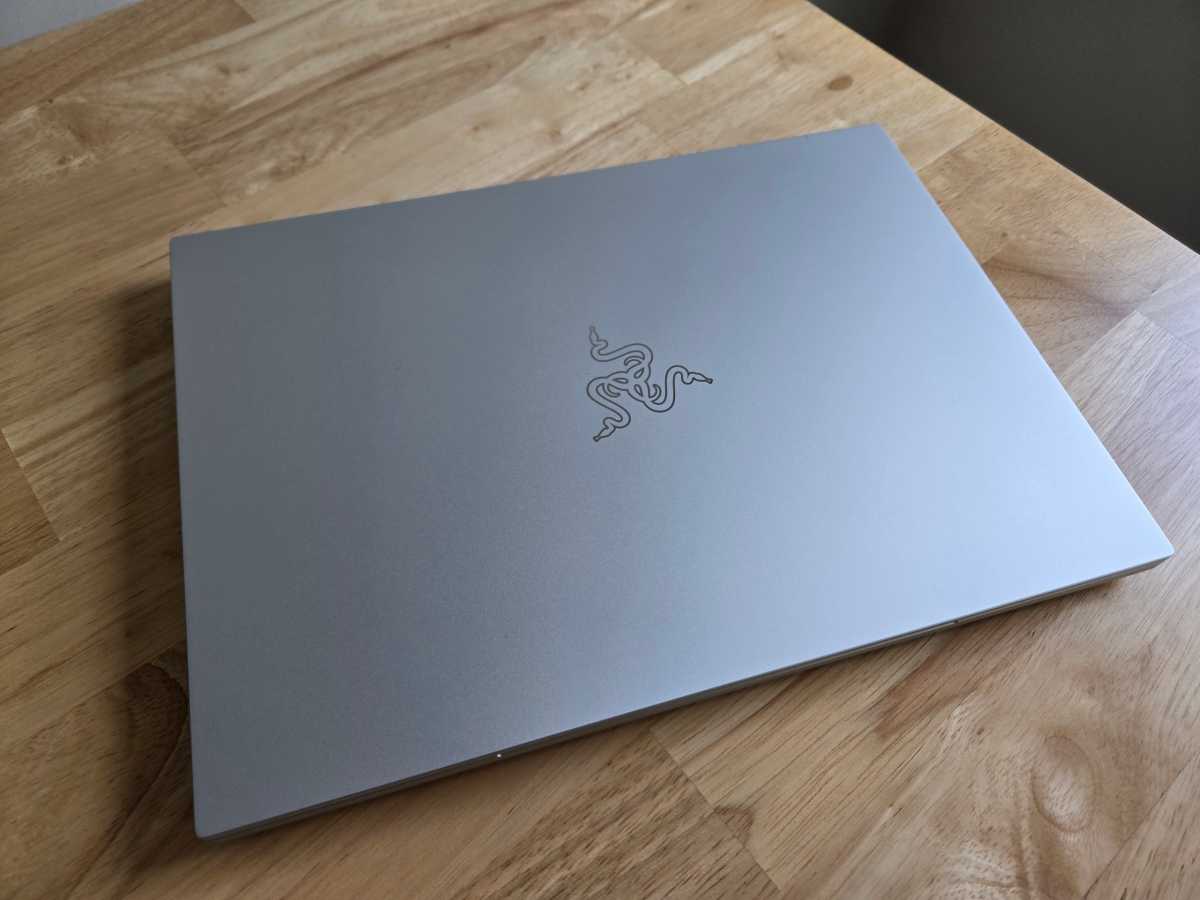
IDG / Chris Hoffman
The 14-inch Razer Blade 14 is the most compact gaming laptop Razer offers, alongside the larger Razer Blade 16 and Razer Blade 18. Razer says this is the thinnest Blade 14 it’s ever created, and at 0.62 inches thick and 3.59 pounds, it’s unusually portable for a gaming laptop with Nvidia GeForce graphics.
The build quality is excellent — the chassis is made of solid aluminum, the hinge is smooth and easy to open with one hand, and it keeps the display solidly in place without any jostling during gaming sessions.
Our review model, with its silver-toned “Mercury White” color has a surprisingly understated design for a gaming laptop. It’s all silver and black with a very restrained Razer logo on the lid. There are no blinking LEDs here — aside from the keyboard backlighting. With per-key LED lighting, you can create animated rainbow LED effects on the keyboard — or just switch it to pure white light for stealth mode. It looks professional and will blend in as a “normal” laptop to anyone who doesn’t recognize the Razer logo on the lid.
Razer Blade 14: Keyboard and trackpad

IDG / Chris Hoffman
The Razer Blade 14 has an awesome keyboard that feels great to use. On paper, the 1mm key travel isn’t a lot. But Razer also says the keys have 63g actuation force. That combination translates to a snappy keyboard experience without a lot of travel.
The keyboard here also supports per-key backlighting, so you can customize the color of each key in the Razer Chroma app — or activate complex animations. It’s the kind of thing that makes the laptop feel even more premium, and it lets you activate that rainbow LED “gamer” aesthetic — but only if you want it, and without blinking LEDs elsewhere on the laptop.
The Razer Blade 14’s trackpad is great. It’s extremely wide and comes right up to the lip of the laptop, and it’s smooth and responsive. Palm rejection is very good, so I didn’t have a problem with it getting in the way while playing games, despite its size. I’d prefer a haptic trackpad, but it’s fine. The click-down action feels great — and it’s quiet, which is underrated when many laptop trackpads make loud clicking sounds — but a haptic trackpad means that the top part of the trackpad would be clickable, too.
Razer Blade 14: Display and speakers
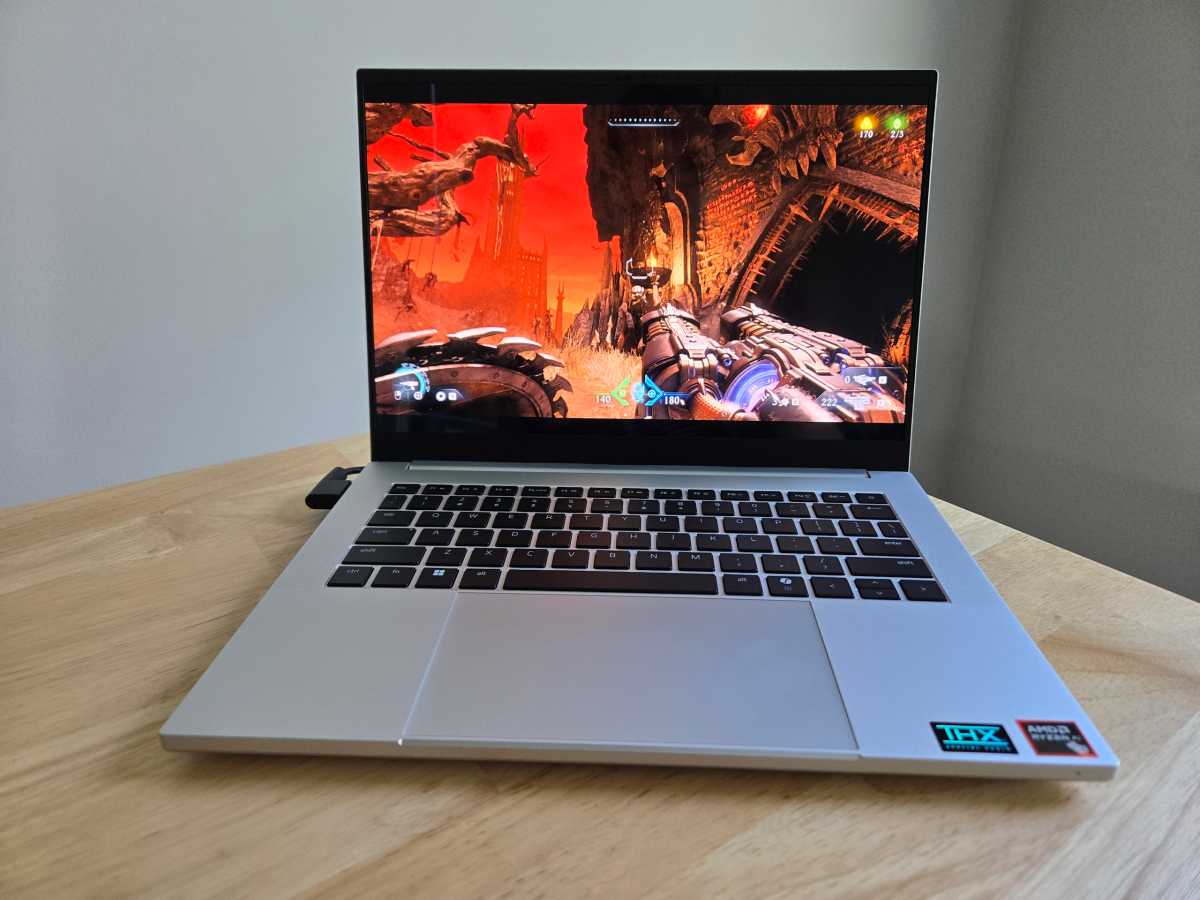
IDG / Chris Hoffman
The Razer Blade 14 has an absolutely beautiful 14-inch display. It’s a 2880×1800 OLED display, and it produces incredibly vivid colors. At a 120Hz refresh rate, it’s also nice and smooth. I do wish it supported HDR — and you can get higher refresh rate displays if you choose a laptop with an IPS display instead — but this display looks amazing. I’m a big fan of OLED displays, and this is a great one.
The Razer Blade 14’s speakers sound great for a laptop. The weapon-firing sounds in DOOM: The Dark Ages sounded nice and punchy. In music, there’s surprisingly crisp instrument separation in Steely Dan’s Aja for laptop speakers. Playing Daft Punk’s Get Lucky, there’s a fun sound with a bit of bass.
The volume level is good, although I’ve heard much louder laptop speakers; it’s good but doesn’t have the loudest top-end volume I hear on other laptops. Bass is the one thing that’s lacking compared to a good pair of headphones or external speakers, but there’s enough bass to make the speakers usable. (Still, a good pair of headphones or external speakers will be a big upgrade to your gaming or multimedia experience.)
Razer Blade 14: Webcam, microphone, biometrics
The 1080p webcam included here is surprisingly good. It delivers a clear picture with good color reproduction — nothing grainy or washed out. And, because this is a Copilot+ PC, you get access to the AI webcam tweaks in Windows Studio Effects.
The microphone sounds clear and has good noise reduction, but the audio could be a bit clearer. It’s no big deal. But, while I’d be happy using the built-in webcam for video meetings, I’d definitely prefer to use an external mic for gaming sessions.
The Razer Blade 14 has an IR camera for Windows Hello, and it works well. I prefer these to fingerprint readers: It’s nice to open your laptop and have it automatically sign in when it sees your face.
Razer Blade 14: Connectivity

IDG / Chris Hoffman
The Razer Blade 14 has a compelling selection of ports for a 14-inch laptop — including two USB Type-C ports (USB4 speeds) and two USB Type-A ports (USB 3.2 Gen 2 speeds).
On the left, you’ve got a power port along with a USB Type-C port, USB Type-A port, and combo audio jack. On the right, you’ll see a microSD card reader, a second USB Type-C port, a second USB Type-A port, an HDMI 2.1 out port, and a Kensington lock slot.
That’s about all you could want here — the only thing you could ask for is an Ethernet port, and I doubt one would physically fit here given the size of the laptop!
This laptop also has Wi-Fi 7 and Bluetooth 5.4 support, making it nice and future proof for the latest standards. I had no problem with the Wi-Fi.
Razer Blade 14: Performance
The Razer Blade 14 performed great in both gaming and real-world desktop use — naturally. The cooling system works well and blasts the hot air out of the back of the machine, not out of the sides where it would blow on your mouse hand. The keyboard stays surprisingly cool for a gaming laptop.
The metal above the F key row can become rather hot while gaming, so that’s where so much of the heat is being redirected to. It ran DOOM: The Dark Ages great, with smooth gameplay even on high graphical detail settings. And the fans stayed surprisingly quiet for a compact gaming laptop that needs to vent a lot of heat, too — no loud whirring jet engine noise, as with some gaming laptops.
As always, we ran the Razer Blade 14 through our standard benchmarks to see how it performs compared to competing laptops.
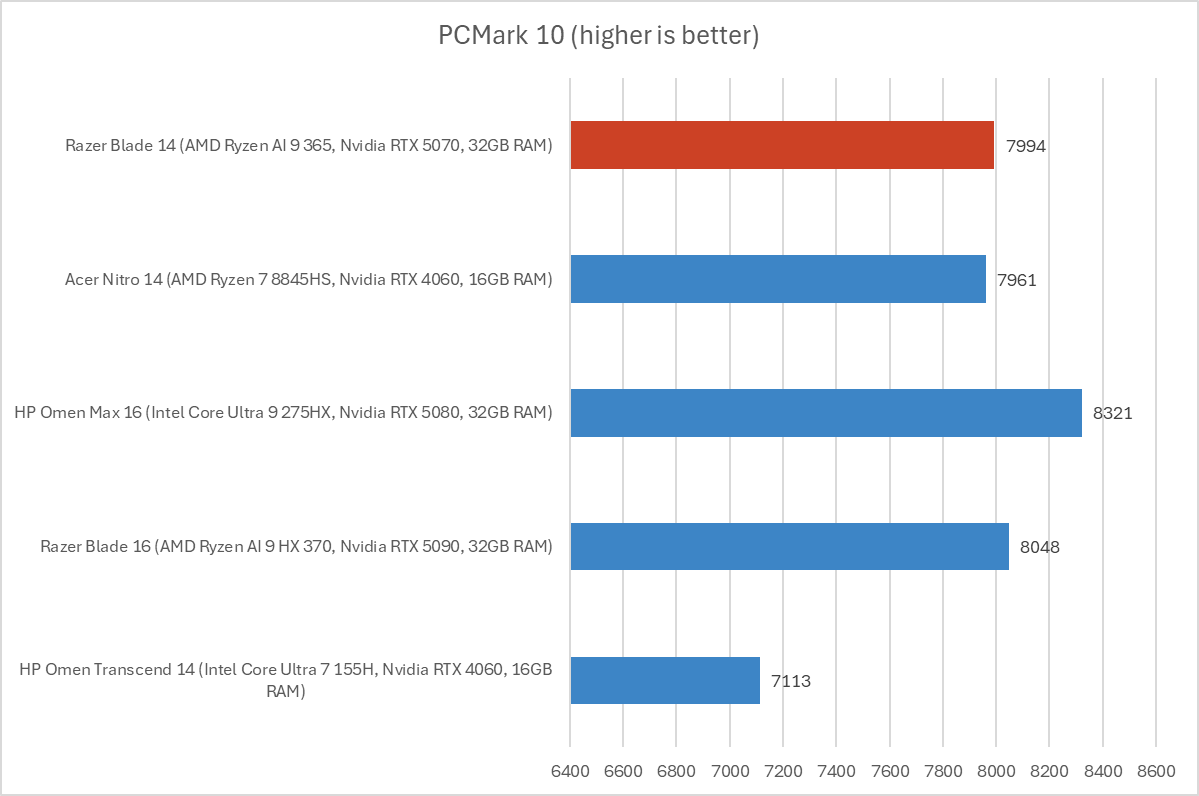
IDG / Chris Hoffman
First, we run PCMark 10 to get an idea of overall system performance. With an overall PCMark 10 score of 7,994, this machine delivered similar overall performance to the 16-inch Razer Blade 16 on this benchmark and only fell a bit short of the HP Omen Max 16 with its higher-end and more power-hungry Intel Core Ultra 9 CPU.
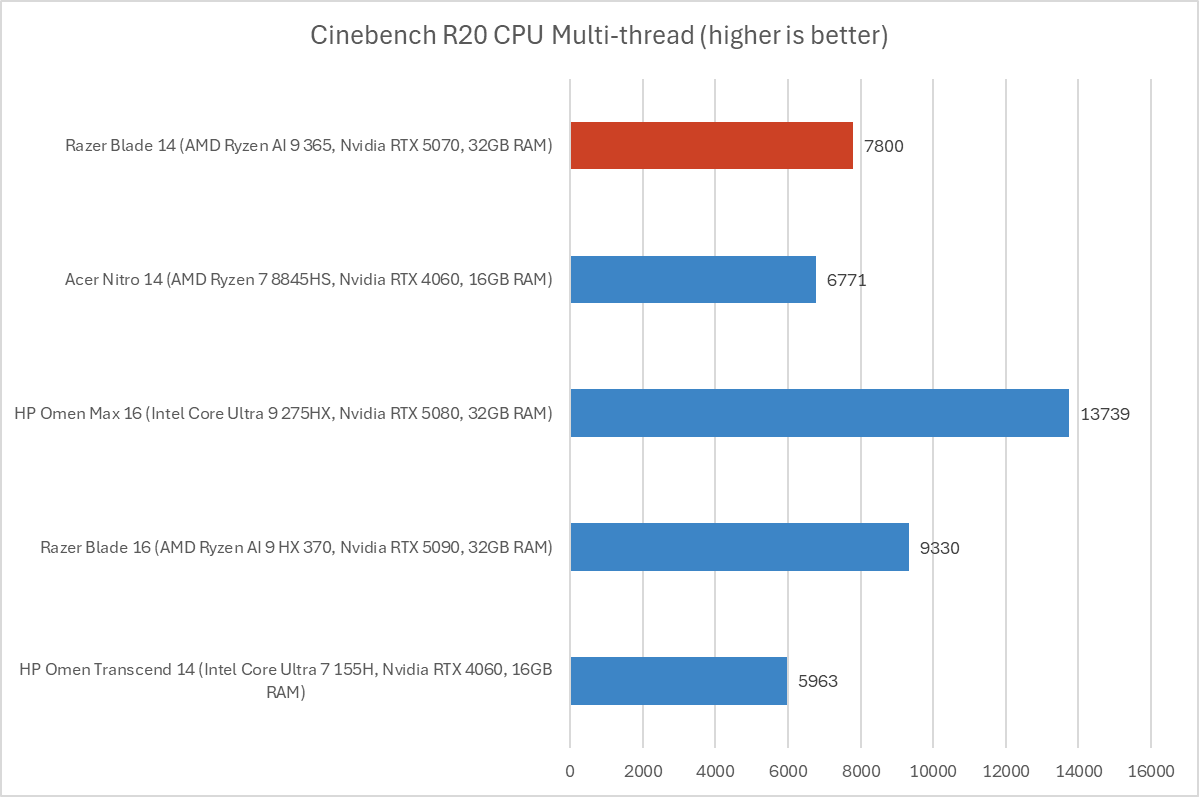
IDG / Chris Hoffman
Next, we run Cinebench R20. This is a heavily multithreaded benchmark that focuses on overall CPU performance. Since it’s heavily multithreaded, CPUs with more cores have a huge advantage.
With a multithreaded score of 7,800, this system delivered good numbers — falling short of systems with more cores, naturally. The AMD Ryzen AI 9 365 chip here has 10 cores, while the 370 chip in the Razer Blade 16 has 12 cores. The Intel Core Ultra 9 275HX has a whopping 24 cores. You can see how that affects performance in multithreaded CPU benchmarks, but the difference in real-world gaming performance can be marginal.
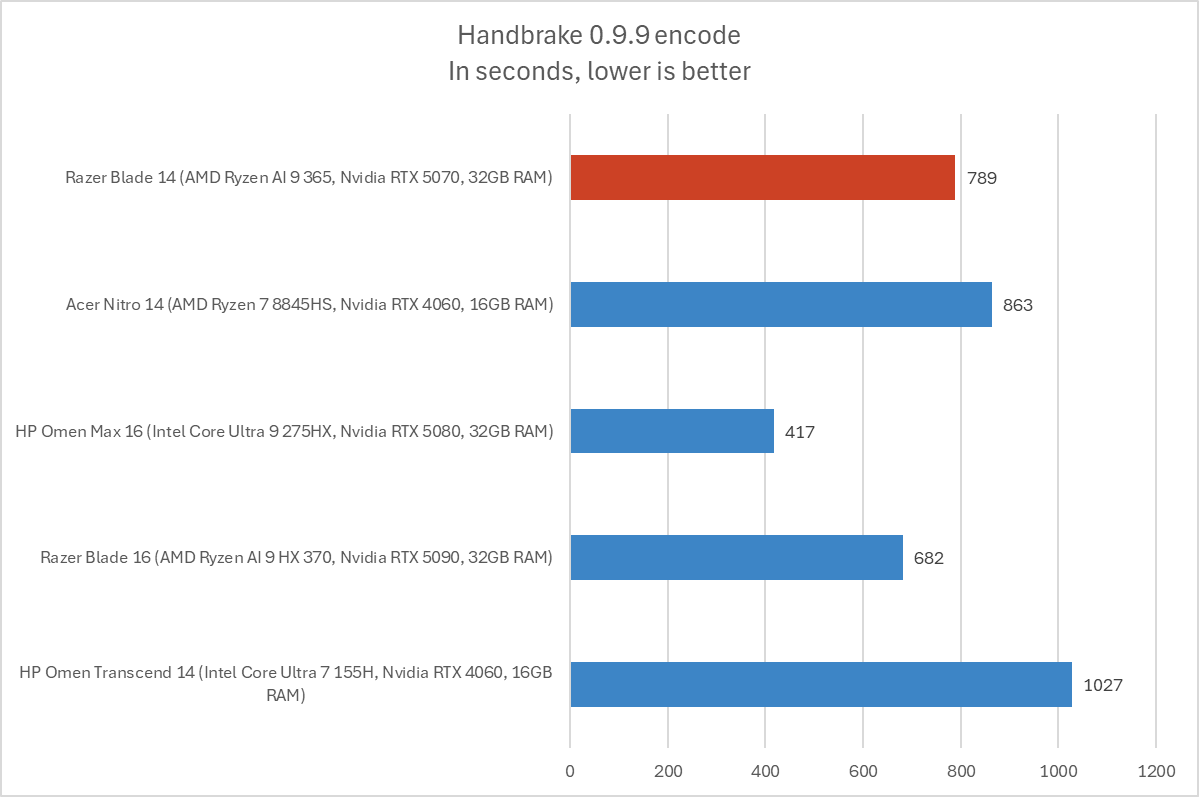
IDG / Chris Hoffman
We also run an encode with Handbrake. This is another heavily multithreaded benchmark, but it runs over an extended period. This demands the laptop’s cooling kick in, and many laptops will throttle and slow down under load.
The Razer Blade 14 completed the encode process in 789 seconds — that’s just over 13 minutes. Once again, only laptops with CPUs that have more cores performed better.

IDG / Chris Hoffman
Next, we benchmark the laptop’s GPU. We start with 3Dmark Time Spy, a graphical benchmark that focuses on GPU performance.
With a 3DMark Time Spy score of 13,069, the Razer Blade 14 sits in the middle here. Laptops with Nvidia RTX 5080 or 5090 graphics will of course be faster — but it’s harder to pack a higher-end GPU in a compact machine! Compared to the other 14-inch laptops in our benchmark table, you can see how much faster Razer’s machine is than an older gaming laptop with Nvidia RTX 4060 graphics.
After that, we run the benchmarks built into some games. First, we use the benchmark in Shadow of the Tomb Raider to test all the gaming laptops we review. It’s an older game, but it’s a great way to compare GPU performance across different PCs.
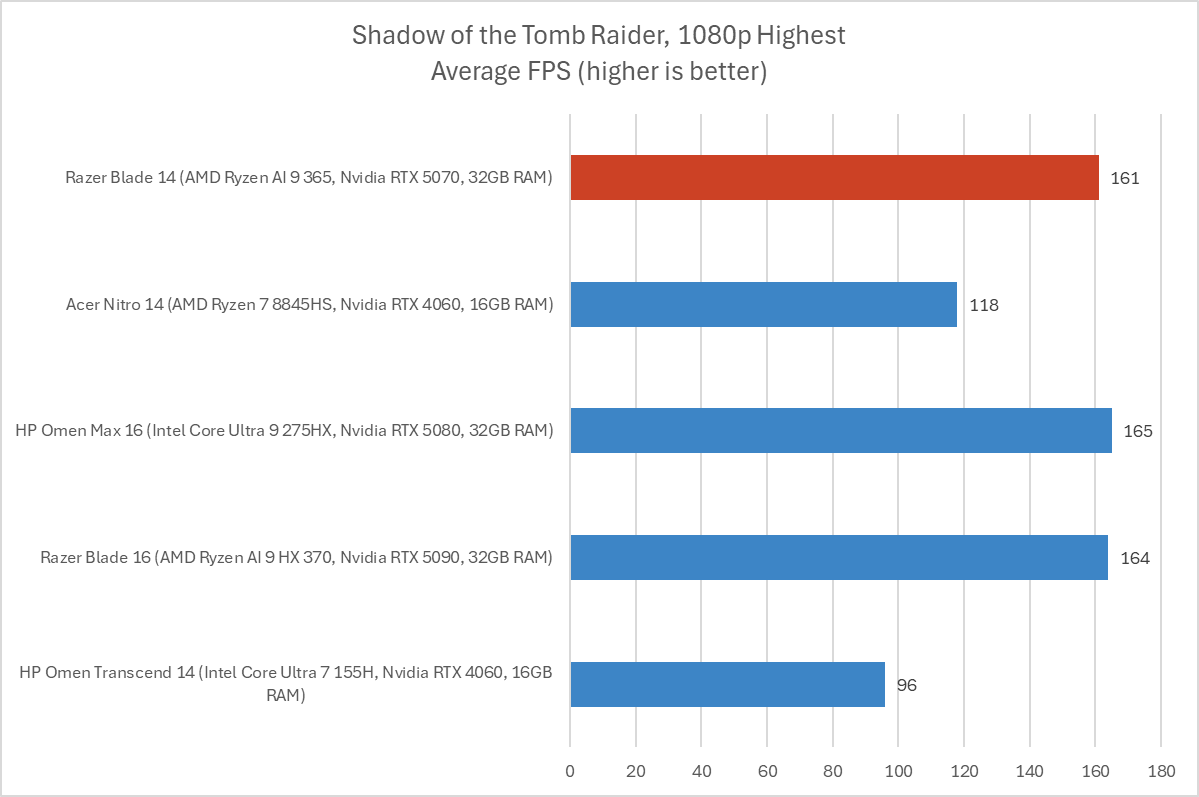
IDG / Chris Hoffman
With an average FPS of 161, the Razer Blade 14 delivered high performance. As you can see, this older game is seeing diminishing returns from higher-end GPUs.
Finally, we run the benchmark in Metro Exodus. This is a more demanding game, and we set the benchmark to 1080p resolution at the Extreme detail setting.
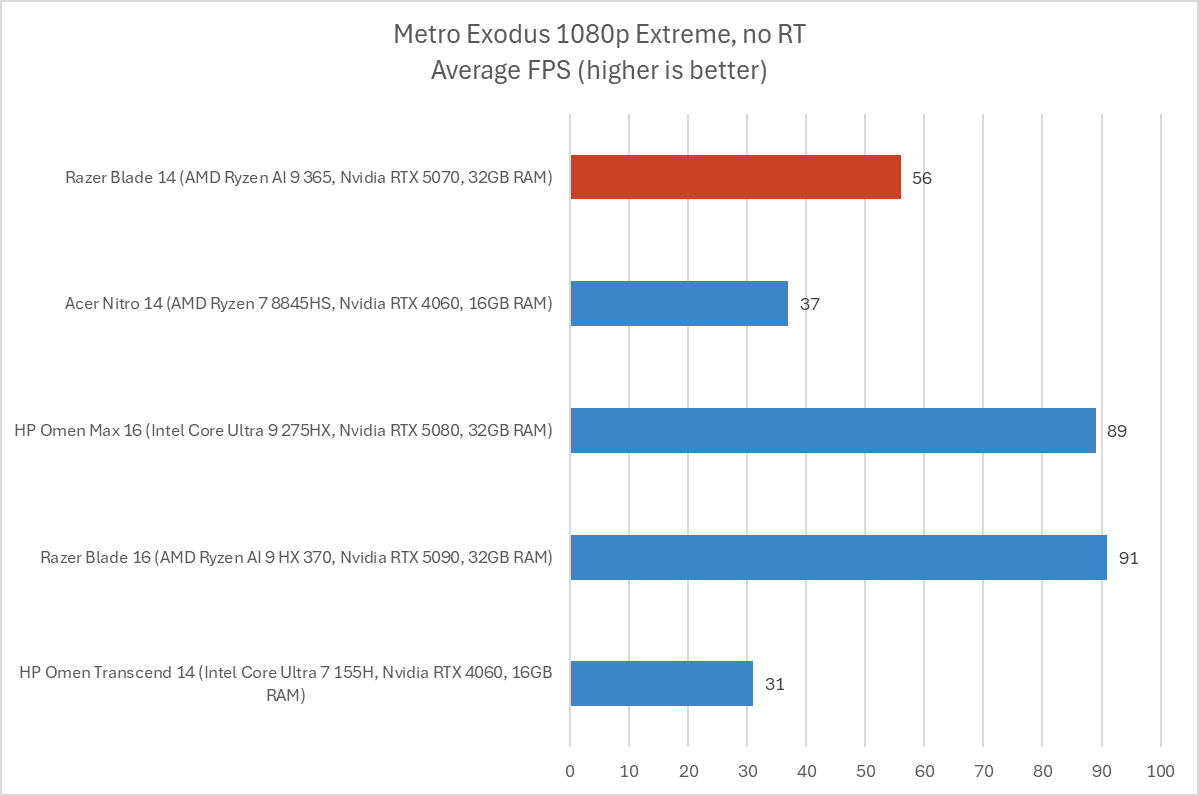
IDG / Chris Hoffman
With an average FPS of 56 in this high-end Metro Exodus benchmark, the Razer Blade 14 delivered playable performance even at these brutal graphical settings. Of course, it comes in behind larger 16-inch laptops with higher-end GPUs.
Overall, the Razer Blade 14 delivered high gaming performance in a compact package with great cooling and quiet fans. This is a great combination of performance and portability if you’re looking for a 14-inch laptop.
Razer Blade 14: Battery life
The Razer Blade 14 includes a 72 Watt-hour battery. Gaming laptops generally aren’t known for their long battery life, but AMD’s Ryzen AI hardware can be surprisingly power efficient, and that’s what we see here. This isn’t going to put up the kind of numbers you see from low-power Qualcomm Snapdragon X or Intel Lunar Lake laptops, but it’s much more power efficient than you might expect in light usage.
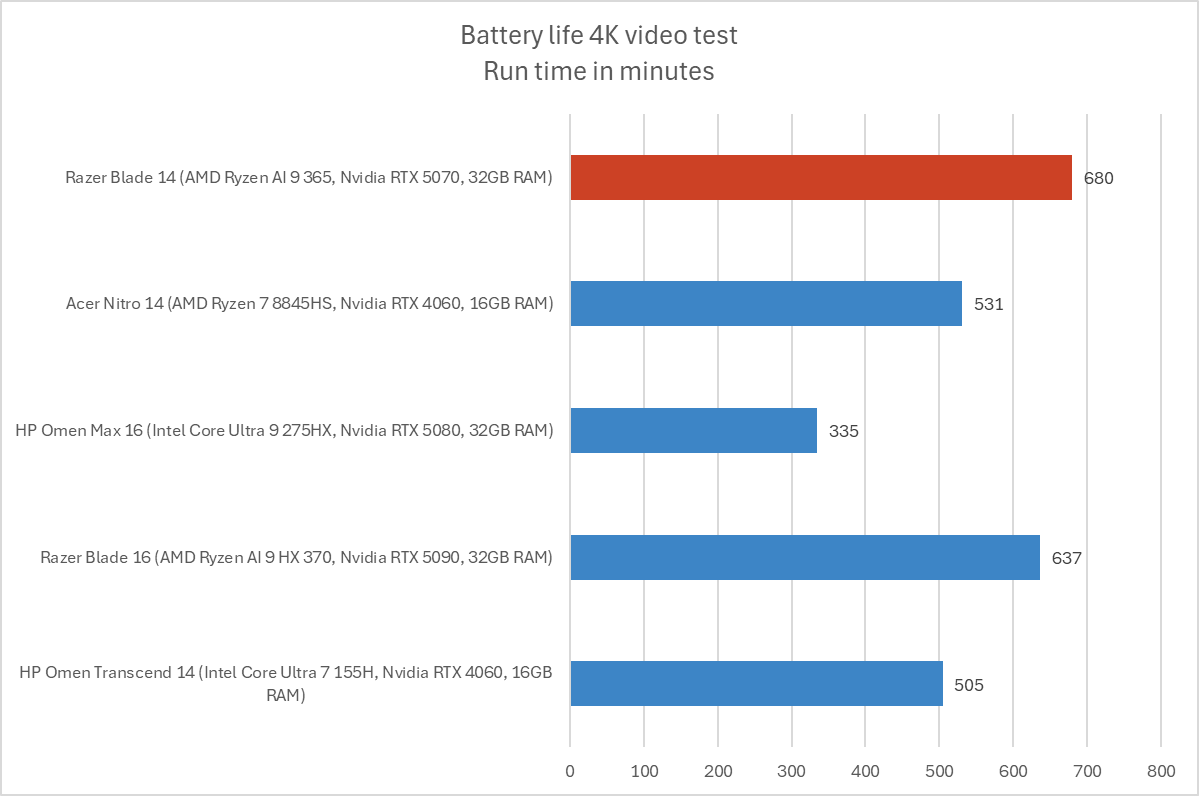
IDG / Chris Hoffman
To benchmark the battery life, we play a 4K copy of Tears of Steel on repeat on Windows 11 with airplane mode enabled and the keyboard backlight turned off until the laptop suspends itself. This is a best-case scenario for any laptop since local video playback is so efficient, and real battery life in day-to-day use is always going to be less than this.
We set the screen to 250 nits of brightness for our battery benchmarks, and it’s worth noting that the Razer Blade 14’s OLED display has a bit of an advantage, as OLED screens use less power to display the black bars around the video.
The Razer Blade 14 lasted for 680 minutes in our benchmark — that’s over 11 hours. Real-world battery life will vary, but this is a great battery life number to see out of a gaming laptop that’s all about power.
Razer Blade 14: Conclusion
The Razer Blade 14 is an excellent gaming laptop in a small package. If you want premium build quality, great gaming performance, and a beautiful display in a compact 14-inch laptop package, it’s a great option. Yes, it’s expensive at $2,699. That’s the big downside — although it was on sale for $2,299 on Razer’s online store while I was finishing this review.
Compared to high-end Razer Blade 16 variants that pair top-end GPUs with thin designs for a high price, this combination of power, portability, and price makes a lot more sense. It’s an excellent machine, but there are tradeoffs: You can get more gaming performance for less money in other, larger gaming laptops. You can get other 14-inch gaming laptops, too — but they won’t feel all this premium or have fans this quiet.
Best Prices Today: Razer Blade 14 (2025)

Author: Chris Hoffman, Contributor, PCWorld

Chris Hoffman is the author of Windows Intelligence, a free email newsletter that brings the latest Windows PC news, trips, and tricks to inboxes each week. He’s also the former editor-in-chief of How-To Geek and a veteran tech journalist whose work has appeared in The New York Times, PCMag, Reader’s Digest, and other publications.
